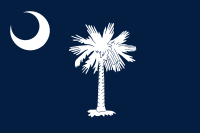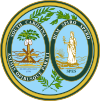Portal:South Carolina
The South Carolina Portal South Carolina (/ˌkærəˈlaɪnə/ ⓘ KARR-ə-LY-nə) is a state in the coastal Southeastern region of the United States. It borders North Carolina to the north, the Atlantic Ocean to the southeast, and Georgia to the southwest across the Savannah River. Along with North Carolina, it makes up the Carolinas region of the East Coast. South Carolina is the 40th-largest and 23rd-most populous U.S. state with a recorded population of 5,118,425 according to the 2020 census. In , its GDP was $213.45 billion. South Carolina is composed of 46 counties. The capital is Columbia with a population of 136,632 in 2020; while its most populous city is Charleston with a 2020 population of 150,227. The Greenville-Spartanburg-Anderson, SC Combined Statistical Area is the most populous combined metropolitan area in the state, with an estimated 2023 population of 1,590,636. South Carolina was named in honor of King Charles I of England, who first formed the English colony, with Carolus being Latin for "Charles". In 1712 the Province of South Carolina was formed. One of the original Thirteen Colonies, South Carolina became a royal colony in 1719. During the American Revolutionary War, South Carolina was the site of major activity among the American colonies, with more than 200 battles and skirmishes fought within the state. South Carolina became the eighth state to ratify the U.S. Constitution on May 23, 1788. A slave state, it was the first state to vote in favor of secession from the Union on December 20, 1860. After the American Civil War, it was readmitted to the Union on July 9, 1868. During the early-to-mid 20th century, the state started to see economic progress as many textile mills and factories were built across the state. The civil rights movement of the mid-20th century helped end segregation and legal discrimination policies within the state. Economic diversification in South Carolina continued to pick up speed during and in the ensuing decades after World War II. In the early 21st century, South Carolina's economy is based on industries such as aerospace, agribusiness, automotive manufacturing, and tourism. (Full article...)
Entries here consist of Good and Featured articles, which meet a core set of high editorial standards.
Stanley Donen (/ˈdɒnən/ DON-ən; April 13, 1924 – February 21, 2019) was an American film director and choreographer. He received the Honorary Academy Award in 1998, and the Career Golden Lion at the Venice Film Festival in 2004. Four of his films have been inducted into the National Film Registry at the Library of Congress. Donen began his career as a dancer in the chorus line on Broadway for director George Abbott. From 1943, he worked in Hollywood as a choreographer before collaborating with Gene Kelly where Donen worked as a contract director for MGM under producer Arthur Freed. Donen and Kelly directed the films On the Town (1949), Singin' in the Rain, and It's Always Fair Weather (1955). Donen's relationship with Kelly deteriorated during their final collaboration. His other films during this period include Royal Wedding (1951), Seven Brides for Seven Brothers (1954), and Funny Face (1957). (Full article...)Selected article -Prior to the civil rights movement in South Carolina, African Americans in the state had very few political rights. South Carolina briefly had a majority-black government during the Reconstruction era after the Civil War, but with the 1876 inauguration of Governor Wade Hampton III, a Democrat who supported the disenfranchisement of blacks, African Americans in South Carolina struggled to exercise their rights. Poll taxes, literacy tests, and intimidation kept African Americans from voting, and it was virtually impossible for someone to challenge the Democratic Party, which ran unopposed in most state elections for decades. By 1940, the voter registration provisions written into the 1895 constitution effectively limited African-American voters to 3,000—only 0.8 percent of those of voting age in the state. Jim Crow laws, legalized by the Supreme Court case Plessy v. Ferguson (1896), created a district color line across the South. African Americans were prohibited from using the same facilities as white Americans, and African-American children were prohibited from attending white schools; schools meant for colored children were typical of lower quality than white schools. Public segregation and voting restrictions were eventually reversed after the events of the civil rights movement in South Carolina and the United States during the 1950s and the 1960s. (Full article...)General images -The following are images from various South Carolina-related articles on Wikipedia.
Did you know -
|
Topics
Categories
New articles
Rules | Match log | Results page (for watching) | Last updated: 2024-05-10 21:51 (UTC)
Note: The list display can now be customized by each user. See List display personalization for details.
- WQIZ (edit | talk | history | links | watch | logs | tools) by Amakuru (talk · contribs · new pages (31)) started on 2024-05-10, score: 20
- Norman Greene (edit | talk | history | links | watch | logs | tools) by WikiQueenJT (talk · contribs · new pages (1)) started on 2024-05-09, score: 50
- Joshua Crockett (edit | talk | history | links | watch | logs | tools) by John Foxe (talk · contribs · new pages (1)) started on 2024-05-08, score: 20
- 2024 Crown Royal Purple Bag Project 200 (edit | talk | history | links | watch | logs | tools) by Tyman9348 (talk · contribs · new pages (4)) started on 2024-05-06, score: 20
- Girard, Montana (edit | talk | history | links | watch | logs | tools) by KjjjKjjj (talk · contribs · new pages (26)) started on 2024-05-06, score: 20
- 2024 Buckle Up South Carolina 200 (edit | talk | history | links | watch | logs | tools) by MysticCipher87 (talk · contribs · new pages (3)) started on 2024-05-05, score: 20
- The Secret Life of Bees (musical) (edit | talk | history | links | watch | logs | tools) by HesioneHushabye (talk · contribs · new pages (16)) started on 2024-05-05, score: 40
- Robert D. Hatcher (edit | talk | history | links | watch | logs | tools) by Suslindisambiguator (talk · contribs · new pages (5)) started on 2024-05-04, score: 31
- Claire Jimenez (edit | talk | history | links | watch | logs | tools) by Ruth Bader Yinzburg (talk · contribs · new pages (4)) started on 2024-05-04, score: 40
- Jefferson Marion Long Jr. (edit | talk | history | links | watch | logs | tools) by MoviesandTelevisionFan (talk · contribs · new pages (64)) started on 2024-05-04, score: 60
- Daniel E. Winstead (edit | talk | history | links | watch | logs | tools) by MoviesandTelevisionFan (talk · contribs · new pages (64)) started on 2024-05-04, score: 40
- Stephanie Mitchem (edit | talk | history | links | watch | logs | tools) by Jaireeodell (talk · contribs · new pages (1)) started on 2024-05-03, score: 20
- 2000 South Dakota Democratic presidential primary (edit | talk | history | links | watch | logs | tools) by Memevietnam98 (talk · contribs · new pages (34)) started on 2024-05-02, score: 30
- 2024 World's Strongest Man (edit | talk | history | links | watch | logs | tools) by Brandon Downes (talk · contribs · new pages (1)) started on 2024-04-30, score: 20
- 1990 NCAA women's golf championship (edit | talk | history | links | watch | logs | tools) by Hey man im josh (talk · contribs · new pages (655)) started on 2024-04-30, score: 48
- Higgins House (edit | talk | history | links | watch | logs | tools) by DemonDays64 (talk · contribs · new pages (1)) started on 2024-04-30, score: 20
- Hampton County High School (edit | talk | history | links | watch | logs | tools) by Bernardgeorgeh (talk · contribs · new pages (1)) started on 2024-04-29, score: 20
- Frank P. Dwyer (edit | talk | history | links | watch | logs | tools) by Pjbermel (talk · contribs · new pages (2)) started on 2024-04-28, score: 20
- Marion D. McGowan (edit | talk | history | links | watch | logs | tools) by MoviesandTelevisionFan (talk · contribs · new pages (64)) started on 2024-04-28, score: 60
- Alfred W. Bethea (edit | talk | history | links | watch | logs | tools) by MoviesandTelevisionFan (talk · contribs · new pages (64)) started on 2024-04-28, score: 70
- William Bratton (Revolutionary War) (edit | talk | history | links | watch | logs | tools) by CaroleHenson (talk · contribs · new pages (8)) started on 2024-04-28, score: 36
- Nick Gargiulo (edit | talk | history | links | watch | logs | tools) by BeanieFan11 (talk · contribs · new pages (59)) started on 2024-04-27, score: 40
- Trajan Jeffcoat (edit | talk | history | links | watch | logs | tools) by Pealingofthebell (talk · contribs · new pages (3)) started on 2024-04-27, score: 30
- Steve Wadiak (edit | talk | history | links | watch | logs | tools) by BeanieFan11 (talk · contribs · new pages (59)) started on 2024-04-26, score: 36
- Ethan Petry (edit | talk | history | links | watch | logs | tools) by GPL93 (talk · contribs · new pages (24)) started on 2024-04-26, score: 40
- Mark Murphy Sings Mostly Dorothy Fields & Cy Coleman (edit | talk | history | links | watch | logs | tools) by CoralRad (talk · contribs · new pages (7)) started on 2024-04-26, score: 20
- Bluffton expedition (edit | talk | history | links | watch | logs | tools) by Ficaia (talk · contribs · new pages (9)) started on 2024-04-26, score: 40
Related portals
WikiProjects
Associated Wikimedia
The following Wikimedia Foundation sister projects provide more on this subject:
-
Commons
Free media repository -
Wikibooks
Free textbooks and manuals -
Wikidata
Free knowledge base -
Wikinews
Free-content news -
Wikiquote
Collection of quotations -
Wikisource
Free-content library -
Wikiversity
Free learning tools -
Wikivoyage
Free travel guide -
Wiktionary
Dictionary and thesaurus













































